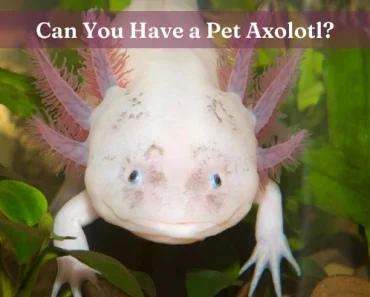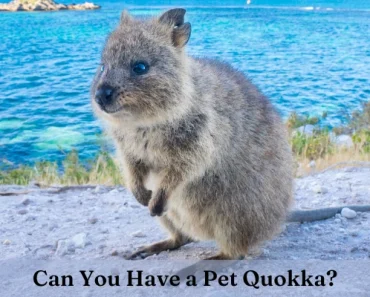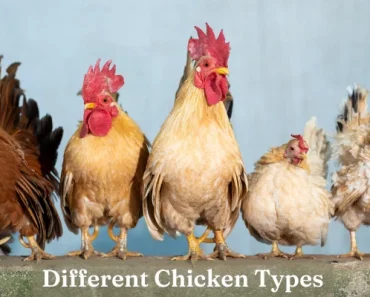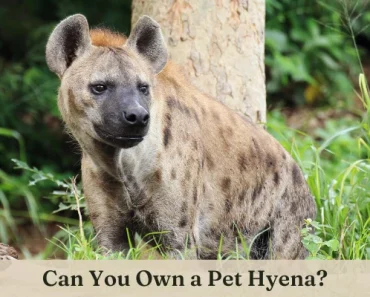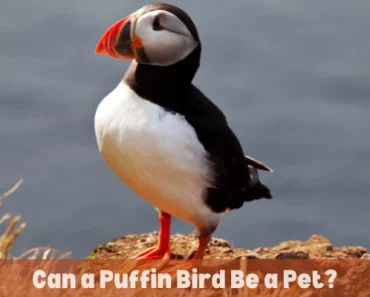Falcons are birds of prey and are not usually considered pets.
Owning a pet falcon isn’t really something that can be accomplished normally, but some people can have a “pet” falcon for the purpose of falconry.
If you want a falcon as a pet, there isn’t much that can be done unless you are willing to go through the steps to become a falconer and get special licenses to keep a “pet falcon“.
Can You Have a Pet Falcon?
Falcons are native species protected under the Migratory Bird Treaty Act of 1918. This act prohibits the capturing, killing, trading, and transporting of any native birds and encompasses all of North America.
The only exception is for licensed falconers with a “general class” license.
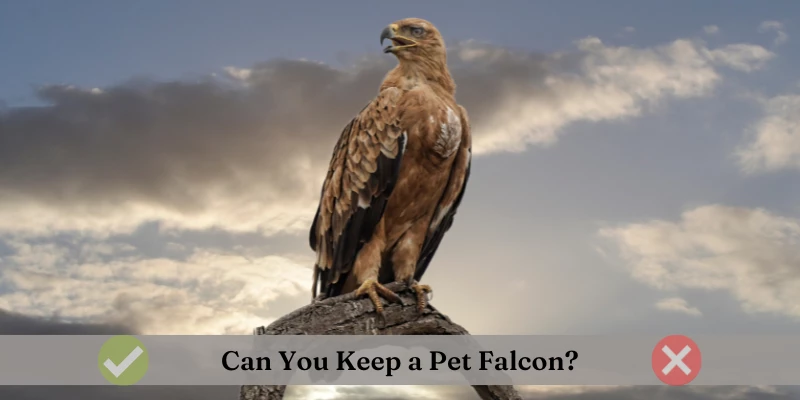
Can You Have a Pet Falcon in The United States (U.S.)?
Falcon species fall under the Migratory Bird Treaty Act prohibiting people from owning pet falcons in the United States. The treaty prohibits the capture, kill, trade, and transport of any falcon within the U.S unless you have been authorized prior by the Department of Fish and Wildlife.
If you don’t hold a general class license as a falconer, you will not be permitted to have a falcon as a pet in the United States.
Although most falconers probably wouldn’t consider their animal a pet falcon either since they aren’t technically pets.
Can You Have a Pet Falcon in Canada?
In Canada, falcons fall under the Migratory Bird Treaty Act, and having a pet falcon in Canada is not legal just like in the United States. The only exception is for licensed falconers that have obtained a general class license.
The Migratory Bird Treaty Act covers native bird species in North America that are native to states, countries, and regions.
Can You Have a Pet Falcon in Australia?
Pet falcons are illegal in Australia without valid and appropriate permits. It is illegal to keep any bird of prey as a pet unless you go through the proper channels and get the proper licenses.
These permits and licenses won’t be easy to obtain and are usually reserved for parks, zoos, and regulated projects.
Much of the Australian wildlife requires special permits, including birds of prey such as falcons, hawks, and eagles – just to name a few.
Can You Have a Falcon as a Pet in The United Kingdom (UK)?
Wild birds of prey are illegal to keep in captivity in the UK according to the Wildlife and Countryside Act 1981, which makes pet falcons illegal. This Act states no person shall injure, kill, take, disturb, or trade wild animals (including falcons).
Since falcons are considered birds of prey, it will be tricky to have a pet falcon in the UK.
Even if you intend to obtain a pet falcon for the purpose of falconry, you will need to find a falcon that has already been bred in captivity and not wild.
Exotic pet laws may differ from region to region, so it is best to check with your local officials to determine if a pet falcon is legal or illegal in your area.
7 Popular & Common Species of Falcons
Below are details about 7 common species of falcons, which include: American kestrels, Aplomado falcons, Grey falcons, Gyrfalcons, Peregrine falcons, Prairie falcons, and Merlins.
1. American Kestrel
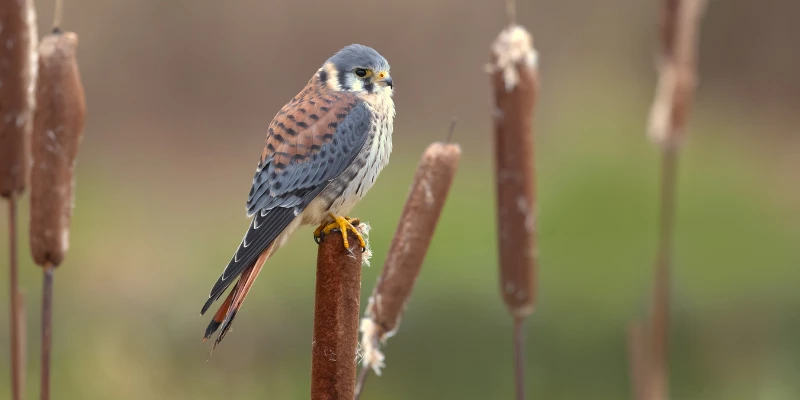
American kestrels, also known as “sparrow hawks” are among the smallest falcon species and one of the most common falcons in the United States and across North America.
American kestrels are amazing and efficient hunters.
American kestrels are around the size of a mourning dove but tend to have more narrow and larger wings with longer, square-shaped tips on their tail.
They average between 8 to 12 inches in length, 2 to 6 ounces in weight, and have a wingspan that spans between 20 to 24 inches.
Most American kestrels sport colors that include brown and orange on their backs, brown and reddish-brown on their heads, black on their tails and on spots of their bodies, slate-blue wings (males), reddish-brown wings (females), and lighter underbelly colors (white, light orange, and light brown).
2. Aplomado Falcon
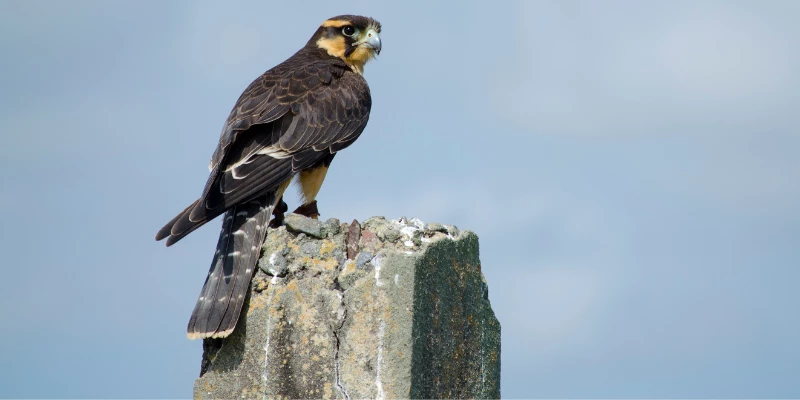
Aplomado falcons are beautiful birds that can be found throughout North America while the majority can be found in habitats throughout South and Central America.
They are currently the only falcon bird that is listed as an endangered species.
Aplomado falcons catch and eat a variety of different prey that includes crabs, insects, rodents, and other birds.
They have sharp talons and hunt in pairs strategically flushing out their prey so one falcon can make the kill (usually the male) while the other falcon creates the diversion or distraction.
An interesting fact about Aplomado falcons is that they (like some other bird species) don’t normally build their own nests.
They are thieves and like to steal the nests of other birds such as crows, hawks, and ravens.
Aplomado falcons can grow to a length between 14 to 18 inches, can weigh between 6 to 14 ounces, and have a wingspan between 30 to 35 inches.
They sport colors like grey, black, orange, tan, and white.
3. Grey Falcon
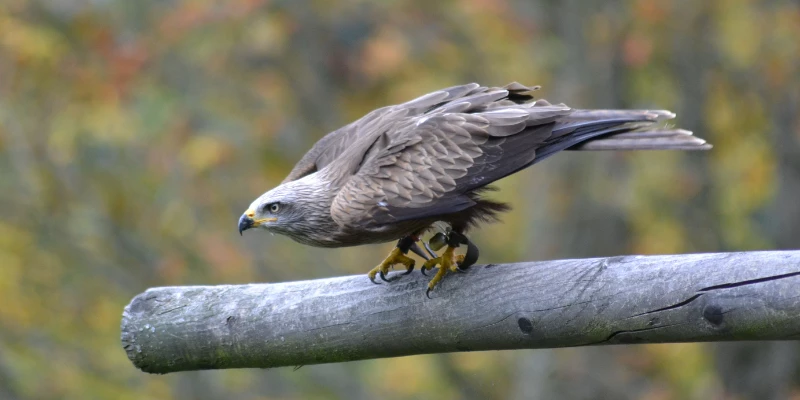
Grey falcons are the rarest falcon species with only close to 2,000 birds left in the world (the majority found in Australia).
This species has similarities to the peregrine falcon with similar builds and hunting habits. Their habitat includes deserts, grasslands, and prairies.
Grey falcons are grey, of course. Their diet consists of smaller birds, fish, small mammals, rodents, and reptiles.
They don’t usually build their own nests but instead like to take over the nests of other birds – including other falcons, hawks, and ravens.
Grey falcons can grow to a length between 12 to 18 inches, can weigh between 7 to 20 ounces, and have a wingspan between 33 to 38 inches.
4. Gyrfalcon
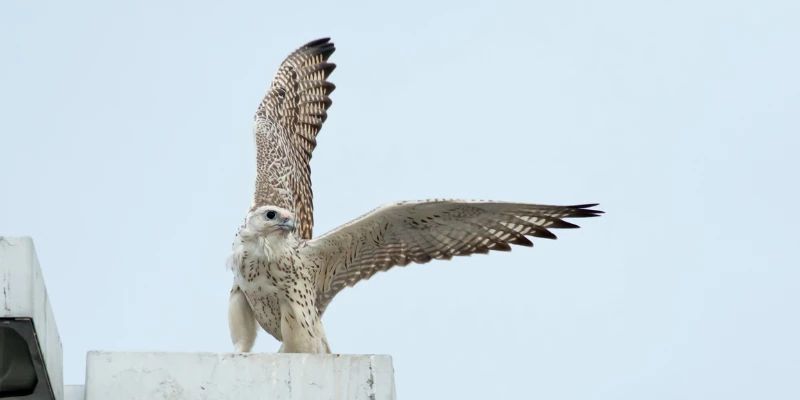
Gyrfalcons are the largest falcon species in the world. They can grow to a length between 19 to 26 inches, can weigh between 1 to 5 pounds, and have a wingspan between 40 to 65 inches.
Female gyrfalcons are usually larger than males.
Gyrfalcons prey on many different animals including ground squirrels, hares, foxes (young), and other small birds.
They will even eat other birds of prey including hawks and other falcon species. Gyrfalcons can be found in Alaska and Canada but are mostly secluded away from human interaction in remote areas.
Gyrfalcons have a range of colors that can be lighter or darker. The colors don’t change as much as in other falcon species between male and female gyrfalcons.
5. Peregrine Falcon
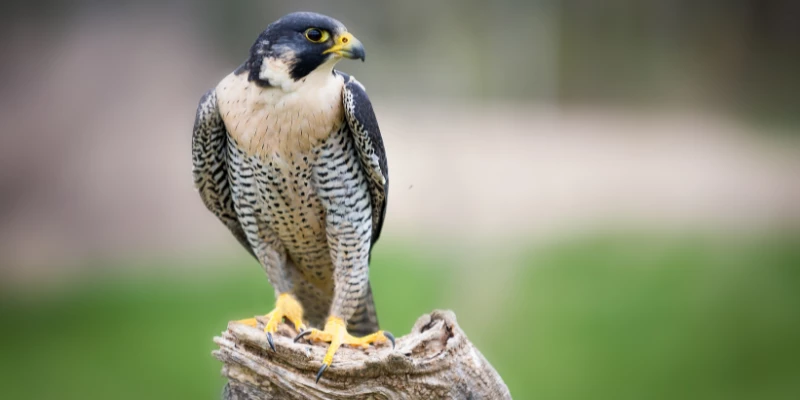
Peregrine falcons are deadly aerial predators that are accomplished as birds of prey. They are spread out throughout the world and can be found on all continents except for Antarctica.
Peregrine falcons are efficient hunters that can swoop down on their prey at speeds that rival some of the fastest animals in the world, including cheetahs.
These falcons hunt many other types of birds, bats, and small animals.
Peregrine falcons can grow to a length between 12 to 24 inches, can weigh from 12 to 55 ounces, and have a wingspan between 30 to 50 inches (depending on the falcon’s gender and species).
Their backs are slate grey and black while their chests are white and tan.
6. Prairie Falcon
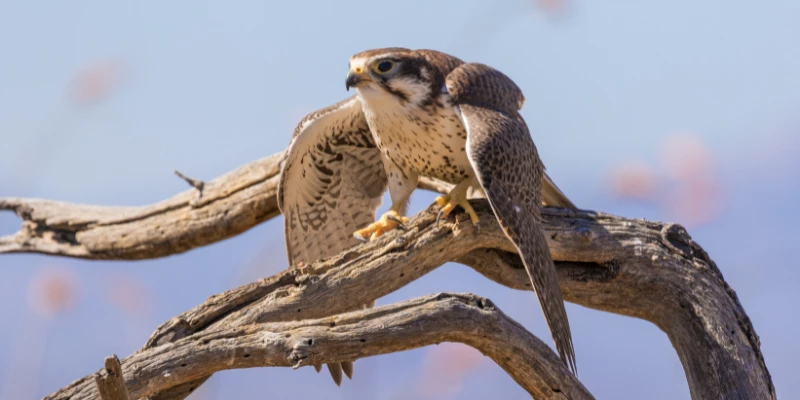
Prairie falcons can be found in grasslands, pastures, deserts, and fields across the western parts of the United States, Canada, and Mexico.
Their prey includes small mammals (rabbits, rats, and squirrels) and other birds depending on their region and the time of year.
Prairie and peregrine falcons have a lot of similarities to the two bird species, but the prairie falcon is slightly smaller.
They have a pale brown back that sort of looks like the back of a turtle (shell). They have light-colored (lighter brown or orange) tails that have black stripes.
Their chests and necks are white to off-white.
Prairie falcons can grow to a length between 14 to 20 inches, can weigh between 15 to 40 ounces, and have a wingspan between 35 to 45 inches.
7. Merlin
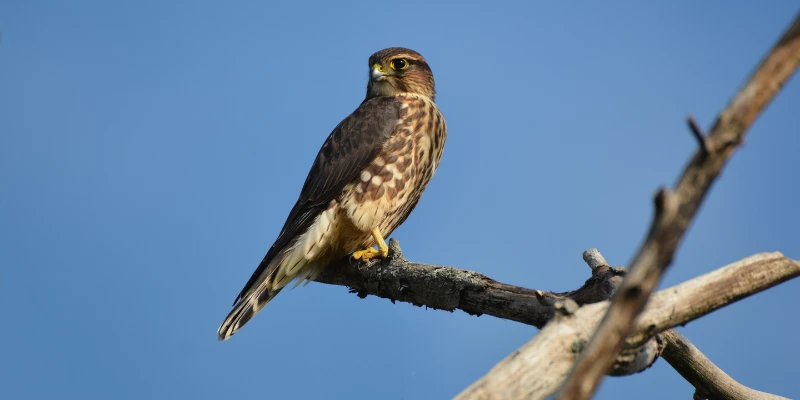
Merlin falcons are smaller falcons that are spread throughout the United States. They are slightly bigger and broader than American kestrels.
Merlin falcons have colors that include black and silver-grey backs (males), brown or reddish-brown backs (females), lighter tan to orange underbellies and chests, and black streaks found on various areas of their bodies.
Merlins can grow to a length between 9 to 13 inches, weigh between 4 to 10 ounces, and have a wingspan between 20 to 23 inches.
They are common in the U.S. and can be found in many different habitats including deserts, grasslands, meadows, and pastures.
Are Falcons Good Pets?
Falcons are not good pets because it is impossible to own a pet falcon. In most areas, falcons can only be used for the purpose of falconry when getting the proper licenses.
Even if it were legal to have a pet falcon, there would be many challenges since not many falcons have been bred in captivity.
Pet falcons would be hard to train to live in a domestic setting.
They require a significant amount of room and special housing, among other needs that most pet owners would not be able to accommodate.
Falcon Physical Details
There are approximately 40 species of falcons found around the world, including all continents except for Antarctica. Many falcons are large birds of prey.
They have sharp beaks, excellent eyesight, and long wingspans.
Falcons are strong birds that have great vision and can dive very fast and change direction with great precision to catch their prey.
Falcon Behavior & Temperament
Below are common questions and answers about the behavior and temperament of falcons.
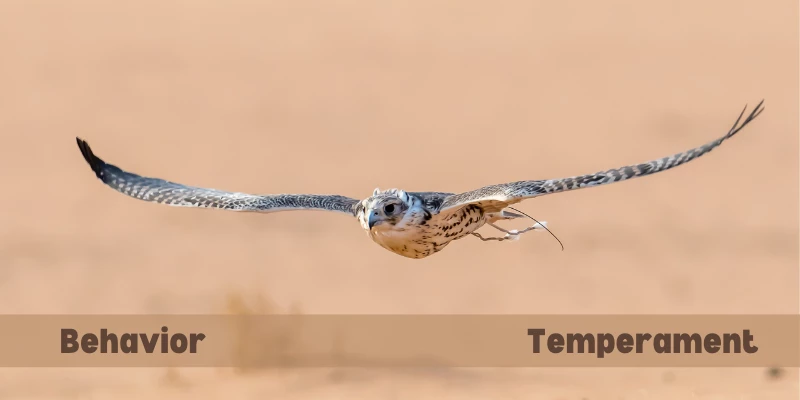
Are Falcons Aggressive?
Falcons are not aggressive birds unless under certain circumstances. Falcons are territorial birds and may attack a human that ventures too close to their territory.
They may feel provoked and will attack in defense, but falcons don’t typically attack humans just for no reason.
Are Falcons Dangerous?
Falcons can be dangerous birds if you encounter one up close or get too close to their territory.
Falcons aren’t known to attack humans for no reason and only go after prey that is comparable to their own size and weight.
If a falcon does attack a human, it can cause significant cuts with its powerful and sharp talons.
Their beaks are powerful and strong, which wouldn’t feel good poking on your head, back, and neck.
Are Falcons Affectionate?
Falcons are not affectionate birds. Depending on the falcon species and the specific bird, you may find one that doesn’t mind being touched and may even like it, but don’t hold your breath.
Most falcons do not want to be around humans and tend to avoid us, whether they are wild or pet falcons.
Are Falcons Solitary?
Falcons are solitary birds that prefer to only spend time in pairs when it is mating season.
During the mating season, a falcon pair will spend several months together but separate and be solitary for the rest of the months of the year.
Are Falcons Territorial?
Falcons are very territorial birds and are top predators. They can become aggressive and dangerous when their territory has been threatened.
Falcons will defend their territory with their sharp talons and can be very fast.
It is best to avoid a falcon’s territory and leave quickly (don’t run) if you find yourself in the territory of a falcon.
What Do Falcons Eat?
Falcons eat small animals such as bats, other birds, pigeons, fish, rabbits, and rodents. Their diet varies based on the falcon species and where they are located.
Most falcons need to eat about a fifth of their body weight per day. Some falcon species will eat even more prey on a daily basis.
Falcon Habitat
Falcons are not limited to just one type of habitat. Since there are many different falcon species, there are also many different types of habitats that they live in.
Falcon Habitat in the Wild
Falcons nest and rest in cliffs, ledges, trees, and in the holes of trees. They can be found in many different regions and in many different habitats.
Falcon Habitat in Captivity
If you could have a pet falcon, they would need lots of space and other special needs. The habitat would need to be large and they would need to have the ability to fly around.
A falcon would need a significant amount of training to be able to be domesticated and kept as a pet.
How Much Do Falcons Cost?
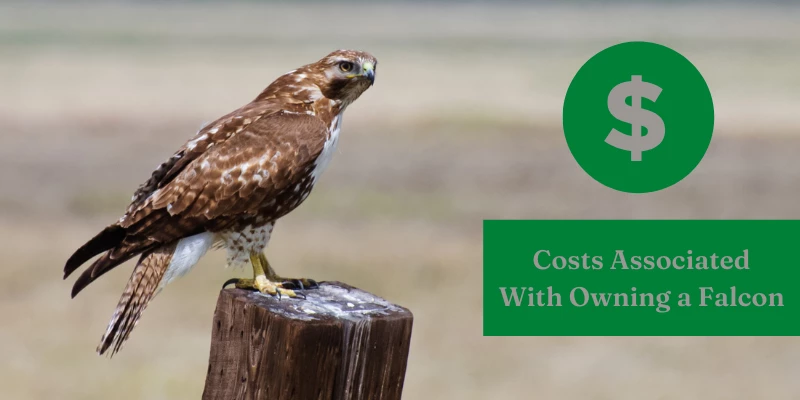
Falcons are only available for sale to licensed falconers and aren’t sold on the market for the purpose of being a pet, but let’s take a look at what falcons cost when they are available.
Initial Cost to Purchase a Falcon
The initial cost to purchase a falcon can range quite dramatically. Some falcons can cost as little as $400 while others can cost a hefty $10,000 or more.
It is hard to determine a good average because the cost varies so much depending on many factors.
Since pet falcons are not legal, there aren’t a lot of breeders selling falcons as pets or even available to falconers.
Ongoing Costs to Own a Falcon
The ongoing costs of owning a “pet falcon” will be higher than your average domestic pet. Falcons require a special diet mainly consisting of meat.
In the wild, they eat a variety of small animals and need to eat around a fifth of their body weight per day.
If your pet falcon weighs 3 pounds, it will need to eat around 10 ounces of food per day.
Pet falcons would need a large enclosure and would need the ability to fly and perform activities as they would normally do in their native environment.
Falcons hunt in a territory ranging from a few miles up to as much as 15 miles from their nests in the wild.
This is their territory range for hunting, mating, and breeding.
Where Can I Buy a Falcon?
You won’t be able to find falcons for sale from exotic pet dealers (at least not legally) for the purpose of having one as a pet.
But falcons are available for sale on the market. You would need to contact a breeder to determine what they require in order to sell you a falcon.
Falcons for Sale
If you want to purchase a falcon, you can check out these websites I found that offer falcons for sale.
I have not purchased a falcon from any of these websites, so ensure you do your research before purchasing a falcon from any of these sites.
There are many other websites to find falcons for sale by doing a quick Google search.
Adopt a Falcon
There are no known adoption agencies that offer pet falcons, but you can symbolically adopt a falcon at any of these non-profit and educational websites.
15 Commonly Asked Questions About Falcons
Below are 15 commonly asked questions (with answers) related to falcons.
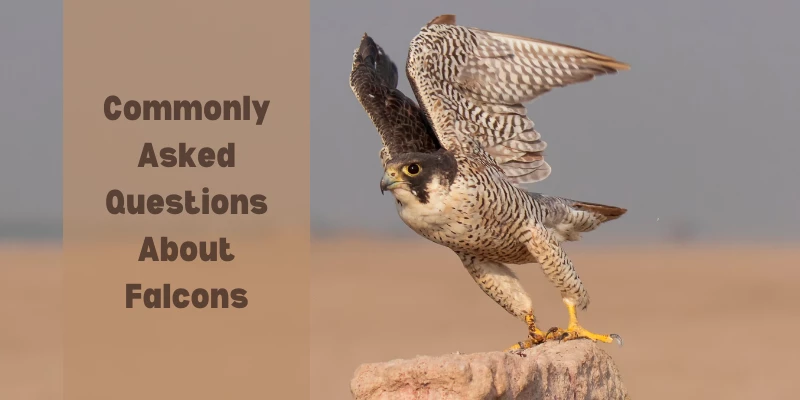
1. Are Falcons Faster than Cheetahs?
Peregrine falcons can rival cheetahs in speed, reaching up to 200 miles per hour when diving for prey.
Cheetahs are touted as faster animals, but when looking at land-to-air comparisons, falcons will win the speed race against cheetahs.
2. Are Falcons Faster than Eagles?
Peregrine falcons are the fastest birds on the planet and can dive faster than the speed of eagles.
Some eagles can dive at a speed up to 150 miles per hour, but peregrine falcons have them beat with diving speeds reaching up to 200 mph.
3. Do Falcons Fly Higher than Eagles?
Eagles can reach heights between 10,000 to 20,000 feet above sea level while falcons can reach heights between 1,000 to 4,000 feet.
Eagles can fly higher than falcons by a considerable distance.
4. How Far Can a Falcon Fly?
Falcons can cover vast distances in the span of a year. They can fly over 15,000 miles in a single year.
Most of this mileage is during the migration season and over the course of the year while hunting prey.
5. How Fast Can a Falcon Fly?
Falcons can fly between 20 to 60 miles per hour with peregrine falcons clocking in as the fastest falcon birds.
They can reach speeds up to and sometimes over 200 miles per hour during their dive to swoop down and snatch up prey.
6. Are Falcons Intelligent?
Falcons are fairly intelligent birds! Some even work in pairs to catch prey. I’ve seen other comments around the internet stating falcons are not smart, but I tend to disagree.
Falcons can work together and flush out prey. Working together to snatch a meal is seen in more intelligent animals.
7. Do Falcons Eat Snakes?
Most falcon species do not have snakes as one of their primary food sources.
Laughing falcons are one of the falcon species that regularly dine on snakes and other reptiles, but the majority of falcons prefer to have diets consisting of other birds, fish, insects, and small mammals.
8. Do Falcons Eat Cats?
Falcons can eat cats but these instances are rare and shouldn’t cause you to lose sleep thinking about your pet cat getting eaten by a falcon.
Falcons don’t usually target cats or other domestic animals unless there is a food shortage and an opportunity presents itself, but again, these are very rare occasions.
9. Do Falcons Eat Dogs?
The majority of dog species are too big and heavy for a falcon to snatch. Dogs are not a preferred meal for most falcons.
It would have to be a small puppy that weighs very little before a falcon can grasp it with its talons.
10. Are Falcons and Hawks the Same Birds?
Falcons and hawks are two different species of birds. Falcons tend to be smaller than hawks, but hawks tend to have shorter wings.
When in flight, it is easy to tell the difference between hawks and falcons because hawks appear to have fingers on their wingtips while falcons have more pointed, slimmer wings.
11. Are Falcons and Eagles the Same Birds?
Falcons and eagles are not of the same bird species. Eagles have larger, heavier bodies than falcons. Eagles also have larger wingspans and bigger beaks than falcons.
Both bird species are considered birds of prey.
12. Are Falcons Raptors?
Birds that are considered raptors include falcons, eagles, hawks, and owls.
They are all called raptors because these bird species use their strong, sharp talons to “seize or grasp” their prey.
13. Are There Male and Female Falcons?
Yes, there are both male and female falcons. Male falcons typically have a whiter chest but female falcons are larger and bulkier than males.
Female peregrine falcons are called “falcons” while males are called “tiercels”.
14. Falcons vs Hawks – Which Bird Species Wins?
Hawks have larger wingspans and are much stronger and more powerful when compared to falcons, but falcons are must faster and should easily escape a hawk if speed is the deciding factor.
However, if a hawk catches a falcon, it would likely overpower the smaller and weaker falcon. So, let’s call it a tie!
15. Are Falcons Friendly?
Falcons are not friendly so don’t go up to one and try to pet it unless you don’t mind being attacked.
They do not care for humans very much and would prefer to keep their distance when possible.
Falcons are not social with humans and fear us, so they like to avoid us unless they become provoked.
Recap
In this article, I provided details on whether pet falcons are legal and how to obtain a falcon as a pet if you are a licensed falconer.
Unfortunately, most of us will never get to experience a pet falcon because of the regulations in place.
I also discussed common types of falcon species and where they can be found. I went over the ways to purchase a falcon and briefly discussed how to adopt a falcon (symbolically).
I detailed various physical and temperament differences between falcon species and provided frequently asked questions about falcons.
I hope this article provided you with useful information about falcons and why they can’t be pets.
If you enjoyed this article, check out some other articles about birds!
